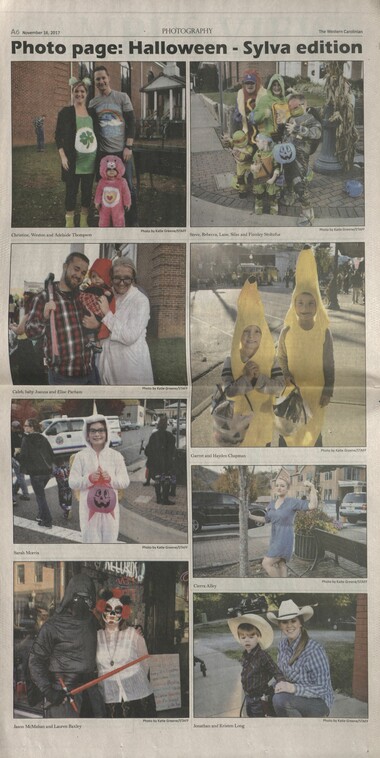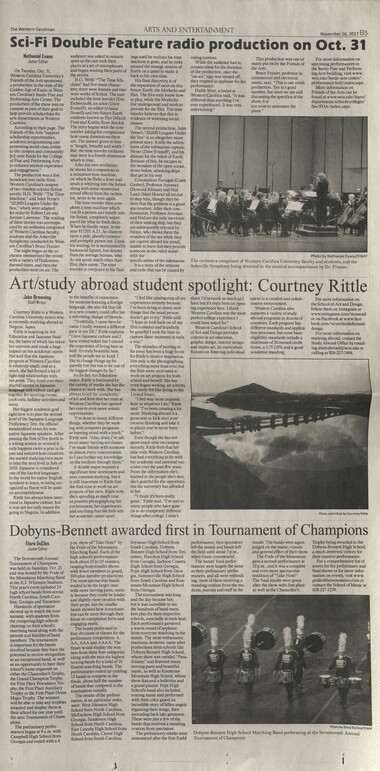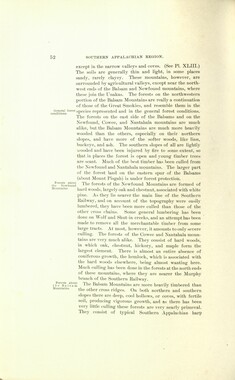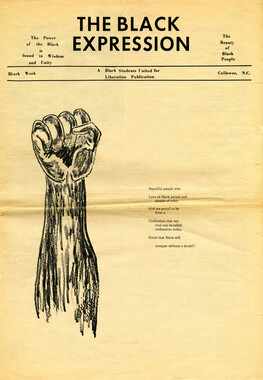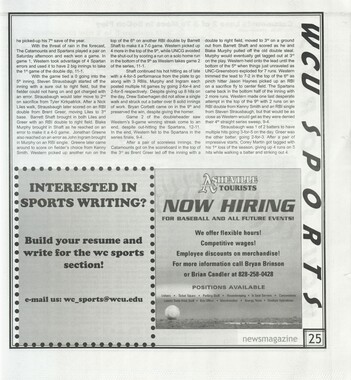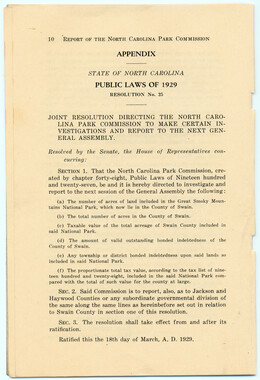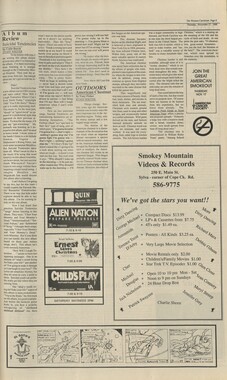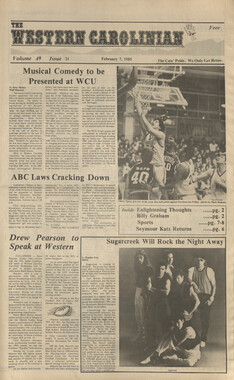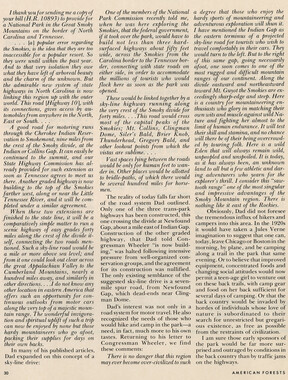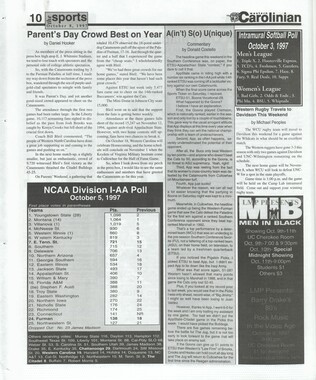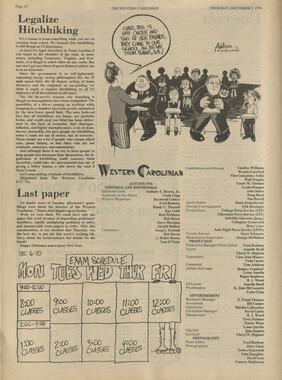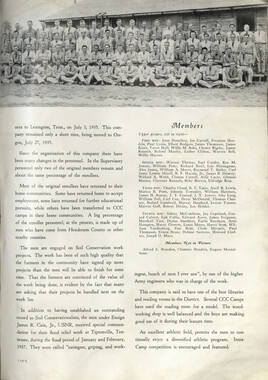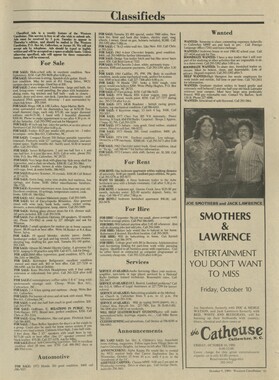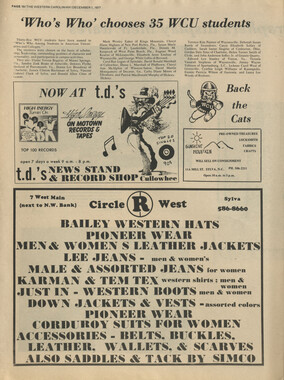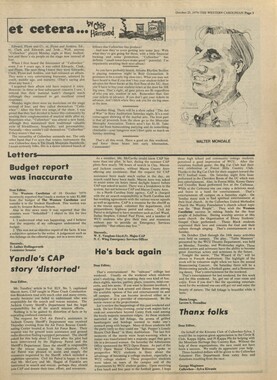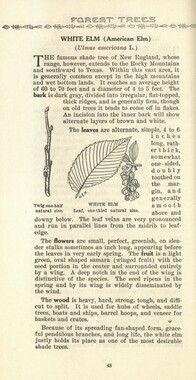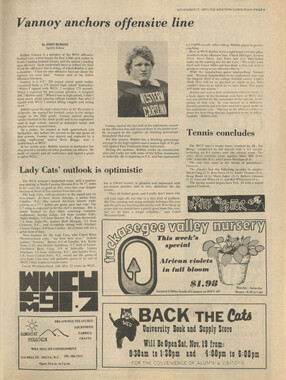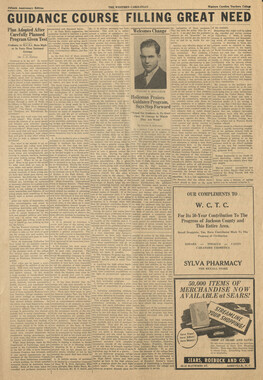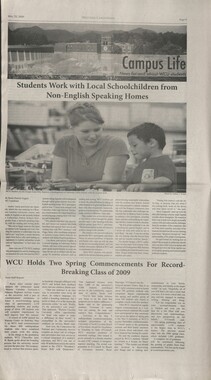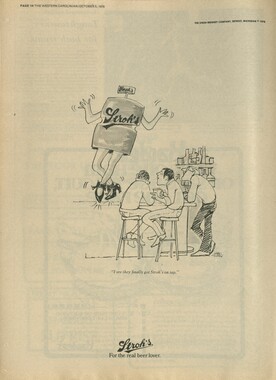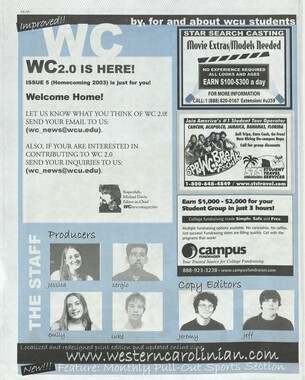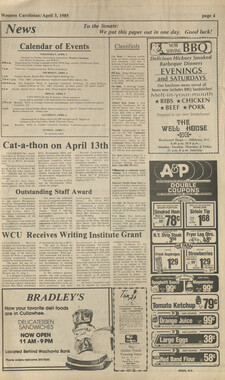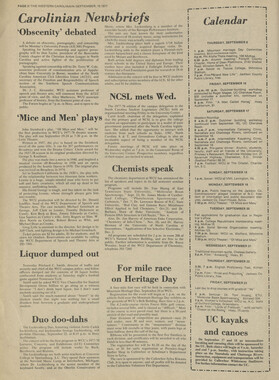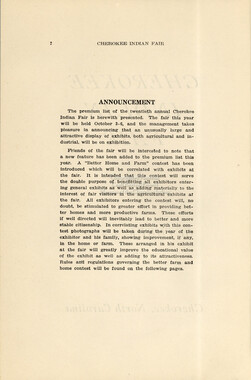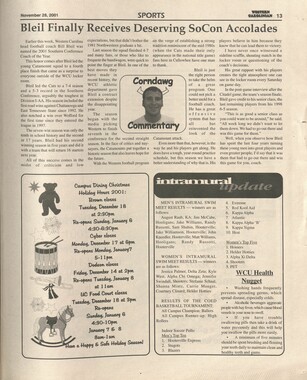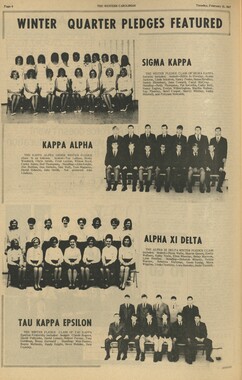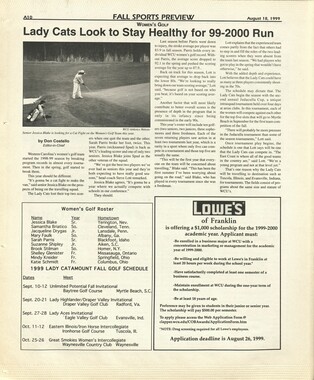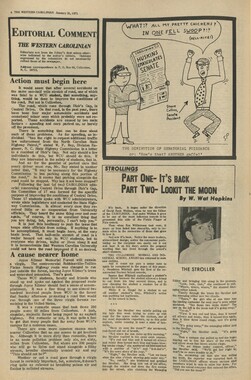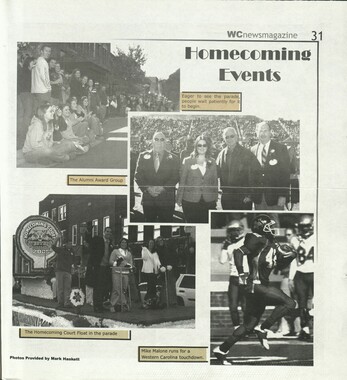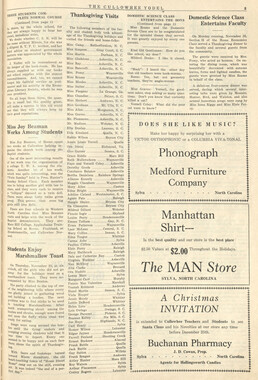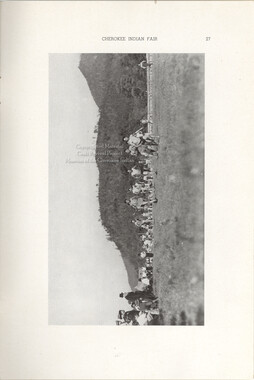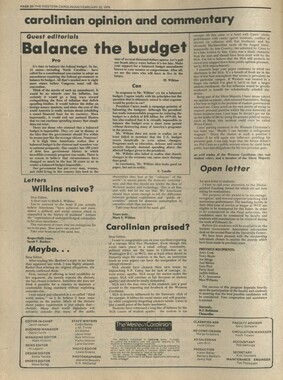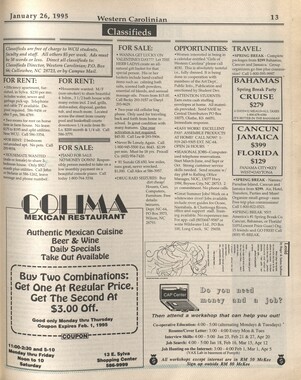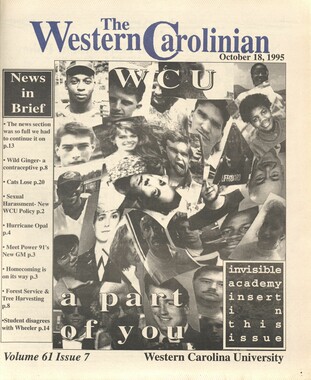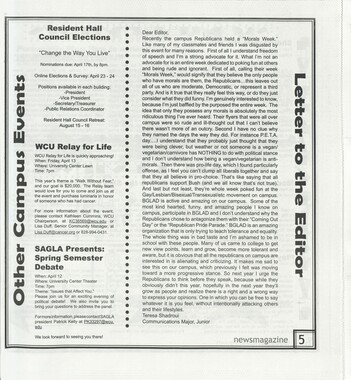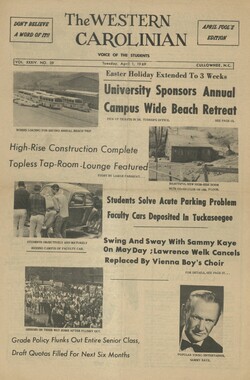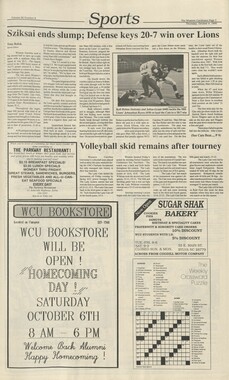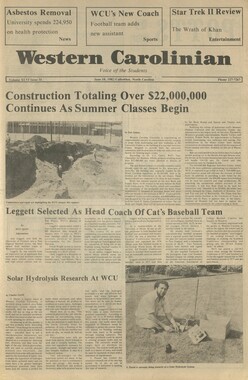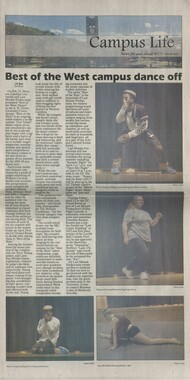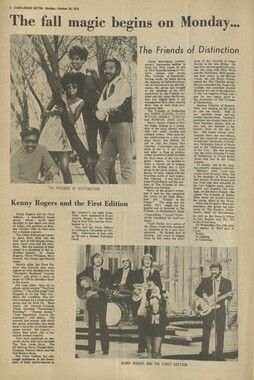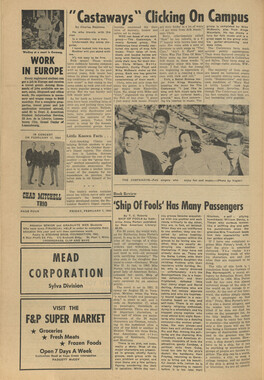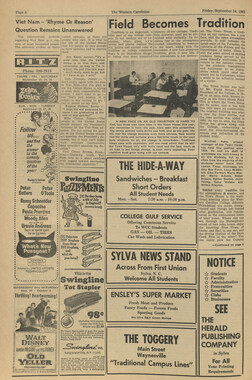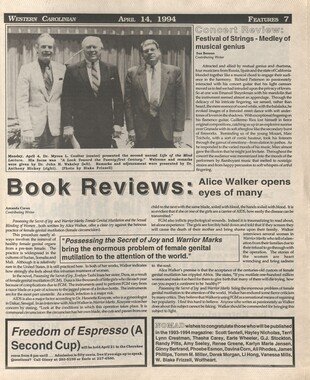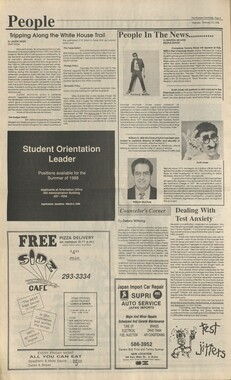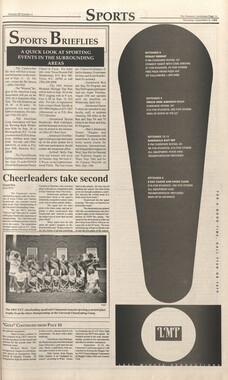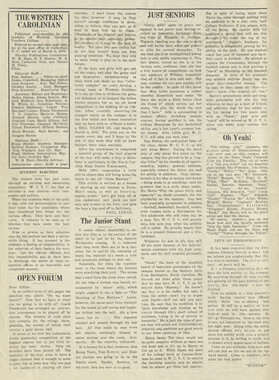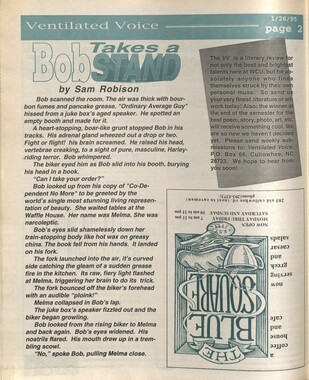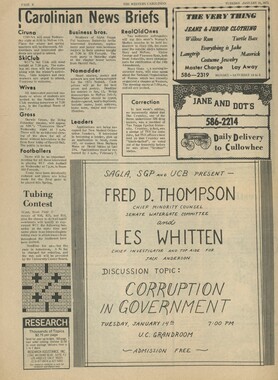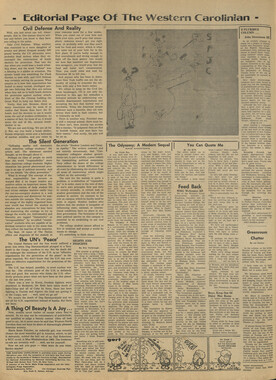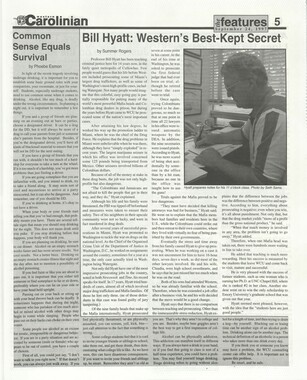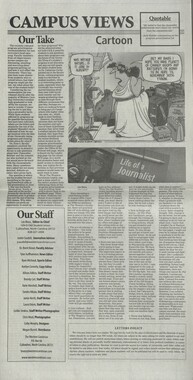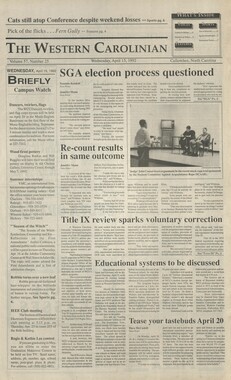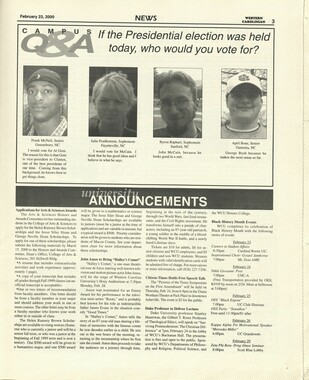Western Carolina University (21)
View all
- Canton Champion Fibre Company (2308)
- Cherokee Traditions (291)
- Civil War in Southern Appalachia (165)
- Craft Revival (1942)
- George Masa Collection (137)
- Great Smoky Mountains - A Park for America (3080)
- Highlights from Western Carolina University (422)
- Horace Kephart (973)
- Journeys Through Jackson (159)
- LGBTQIA+ Archive of Jackson County (89)
- Oral Histories of Western North Carolina (317)
- Picturing Appalachia (6617)
- Stories of Mountain Folk (413)
- Travel Western North Carolina (153)
- Western Carolina University Fine Art Museum Vitreograph Collection (129)
- Western Carolina University Herbarium (92)
- Western Carolina University: Making Memories (738)
- Western Carolina University Publications (2491)
- Western Carolina University Restricted Electronic Theses and Dissertations (146)
- Western North Carolina Regional Maps (71)
- World War II in Southern Appalachia (131)
University of North Carolina Asheville (6)
View all
- Allanstand Cottage Industries (62)
- Appalachian National Park Association (53)
- Bennett, Kelly, 1890-1974 (1463)
- Berry, Walter (76)
- Brasstown Carvers (40)
- Carver, George Washington, 1864?-1943 (26)
- Cathey, Joseph, 1803-1874 (1)
- Champion Fibre Company (233)
- Champion Paper and Fibre Company (297)
- Cherokee Indian Fair Association (16)
- Cherokee Language Program (22)
- Crowe, Amanda (40)
- Edmonston, Thomas Benton, 1842-1907 (7)
- Ensley, A. L. (Abraham Lincoln), 1865-1948 (275)
- Fromer, Irving Rhodes, 1913-1994 (70)
- George Butz (BFS 1907) (46)
- Goodrich, Frances Louisa (120)
- Grant, George Alexander, 1891-1964 (96)
- Heard, Marian Gladys (60)
- Kephart, Calvin, 1883-1969 (15)
- Kephart, Horace, 1862-1931 (313)
- Kephart, Laura, 1862-1954 (67)
- Laney, Gideon Thomas, 1889-1976 (439)
- Masa, George, 1881-1933 (61)
- McElhinney, William Julian, 1896-1953 (44)
- Niggli, Josephina, 1910-1983 (10)
- North Carolina Park Commission (105)
- Osborne, Kezia Stradley (9)
- Owens, Samuel Robert, 1918-1995 (11)
- Penland Weavers and Potters (36)
- Roberts, Vivienne (15)
- Roth, Albert, 1890-1974 (142)
- Schenck, Carl Alwin, 1868-1955 (1)
- Sherrill's Photography Studio (2565)
- Southern Highland Handicraft Guild (127)
- Southern Highlanders, Inc. (71)
- Stalcup, Jesse Bryson (46)
- Stearns, I. K. (213)
- Thompson, James Edward, 1880-1976 (226)
- United States. Indian Arts and Crafts Board (130)
- USFS (683)
- Vance, Zebulon Baird, 1830-1894 (1)
- Weaver, Zebulon, 1872-1948 (58)
- Western Carolina College (230)
- Western Carolina Teachers College (282)
- Western Carolina University (2008)
- Western Carolina University. Mountain Heritage Center (18)
- Whitman, Walt, 1819-1892 (10)
- Wilburn, Hiram Coleman, 1880-1967 (73)
- Williams, Isadora (3)
- Cain, Doreyl Ammons (0)
- Crittenden, Lorraine (0)
- Rhodes, Judy (0)
- Smith, Edward Clark (0)
- Appalachian Region, Southern (3032)
- Asheville (N.C.) (1945)
- Avery County (N.C.) (26)
- Blount County (Tenn.) (195)
- Buncombe County (N.C.) (1680)
- Cherokee County (N.C.) (283)
- Clay County (N.C.) (556)
- Graham County (N.C.) (238)
- Great Smoky Mountains National Park (N.C. and Tenn.) (525)
- Haywood County (N.C.) (3573)
- Henderson County (N.C.) (70)
- Jackson County (N.C.) (4924)
- Knox County (Tenn.) (35)
- Knoxville (Tenn.) (13)
- Lake Santeetlah (N.C.) (10)
- Macon County (N.C.) (421)
- Madison County (N.C.) (216)
- McDowell County (N.C.) (39)
- Mitchell County (N.C.) (135)
- Polk County (N.C.) (35)
- Qualla Boundary (982)
- Rutherford County (N.C.) (78)
- Swain County (N.C.) (2185)
- Transylvania County (N.C.) (270)
- Watauga County (N.C.) (12)
- Waynesville (N.C.) (86)
- Yancey County (N.C.) (72)
- Aerial Photographs (3)
- Aerial Views (60)
- Albums (books) (4)
- Articles (1)
- Artifacts (object Genre) (228)
- Bibliographies (1)
- Biography (general Genre) (2)
- Cards (information Artifacts) (38)
- Clippings (information Artifacts) (192)
- Copybooks (instructional Materials) (3)
- Crafts (art Genres) (622)
- Depictions (visual Works) (21)
- Design Drawings (1)
- Digital Moving Image Formats (2)
- Drawings (visual Works) (185)
- Envelopes (101)
- Exhibitions (events) (1)
- Facsimiles (reproductions) (1)
- Fiction (general Genre) (4)
- Financial Records (12)
- Fliers (printed Matter) (67)
- Glass Plate Negatives (381)
- Guidebooks (2)
- Internegatives (10)
- Interviews (822)
- Land Surveys (102)
- Letters (correspondence) (1045)
- Manuscripts (documents) (618)
- Maps (documents) (177)
- Memorandums (25)
- Minutes (administrative Records) (59)
- Negatives (photographs) (6090)
- Newsletters (1290)
- Newspapers (2)
- Notebooks (8)
- Occupation Currency (1)
- Paintings (visual Works) (1)
- Pen And Ink Drawings (1)
- Periodicals (194)
- Personal Narratives (10)
- Photographs (12977)
- Plans (maps) (1)
- Poetry (6)
- Portraits (4568)
- Postcards (329)
- Programs (documents) (181)
- Publications (documents) (2444)
- Questionnaires (65)
- Relief Prints (26)
- Sayings (literary Genre) (1)
- Scrapbooks (282)
- Sheet Music (2)
- Slides (photographs) (402)
- Songs (musical Compositions) (2)
- Sound Recordings (801)
- Specimens (92)
- Speeches (documents) (18)
- Tintypes (photographs) (8)
- Transcripts (328)
- Text Messages (0)
- A.L. Ensley Collection (275)
- Appalachian Industrial School Records (7)
- Appalachian National Park Association Records (336)
- Axley-Meroney Collection (2)
- Bayard Wootten Photograph Collection (20)
- Bethel Rural Community Organization Collection (7)
- Blumer Collection (5)
- C.W. Slagle Collection (20)
- Canton Area Historical Museum (2110)
- Carlos C. Campbell Collection (462)
- Cataloochee History Project (64)
- Cherokee Studies Collection (4)
- Daisy Dame Photograph Album (5)
- Daniel Boone VI Collection (1)
- Doris Ulmann Photograph Collection (112)
- Elizabeth H. Lasley Collection (1)
- Elizabeth Woolworth Szold Fleharty Collection (4)
- Frank Fry Collection (95)
- George Masa Collection (173)
- Gideon Laney Collection (452)
- Hazel Scarborough Collection (2)
- Hiram C. Wilburn Papers (28)
- Historic Photographs Collection (236)
- Horace Kephart Collection (861)
- Humbard Collection (33)
- Hunter and Weaver Families Collection (1)
- I. D. Blumenthal Collection (4)
- Isadora Williams Collection (4)
- Jesse Bryson Stalcup Collection (47)
- Jim Thompson Collection (224)
- John B. Battle Collection (7)
- John C. Campbell Folk School Records (80)
- John Parris Collection (6)
- Judaculla Rock project (2)
- Kelly Bennett Collection (1482)
- Love Family Papers (11)
- Major Wiley Parris Civil War Letters (3)
- Map Collection (12)
- McFee-Misemer Civil War Letters (34)
- Mountain Heritage Center Collection (4)
- Norburn - Robertson - Thomson Families Collection (44)
- Pauline Hood Collection (7)
- Pre-Guild Collection (2)
- Qualla Arts and Crafts Mutual Collection (12)
- R.A. Romanes Collection (681)
- Rosser H. Taylor Collection (1)
- Samuel Robert Owens Collection (94)
- Sara Madison Collection (144)
- Sherrill Studio Photo Collection (2558)
- Smoky Mountains Hiking Club Collection (616)
- Stories of Mountain Folk - Radio Programs (374)
- The Reporter, Western Carolina University (510)
- Venoy and Elizabeth Reed Collection (16)
- WCU Gender and Sexuality Oral History Project (36)
- WCU Mountain Heritage Center Oral Histories (25)
- WCU Oral History Collection - Mountain People, Mountain Lives (71)
- WCU Students Newspapers Collection (1923)
- Western North Carolina Tomorrow Black Oral History Project (69)
- William Williams Stringfield Collection (2)
- Zebulon Weaver Collection (109)
- African Americans (390)
- Appalachian Trail (35)
- Artisans (521)
- Cherokee art (84)
- Cherokee artists -- North Carolina (10)
- Cherokee language (21)
- Cherokee pottery (101)
- Cherokee women (208)
- Church buildings (190)
- Civilian Conservation Corps (U.S.) (111)
- College student newspapers and periodicals (2012)
- Dams (108)
- Dance (1023)
- Education (222)
- Floods (63)
- Folk music (1015)
- Forced removal, 1813-1903 (2)
- Forest conservation (220)
- Forests and forestry (1198)
- Gender nonconformity (4)
- Great Smoky Mountains National Park (N.C. and Tenn.) (181)
- Hunting (47)
- Landscape photography (25)
- Logging (122)
- Maps (83)
- Mines and mineral resources (9)
- North Carolina -- Maps (18)
- Paper industry (38)
- Postcards (255)
- Pottery (135)
- Railroad trains (72)
- Rural electrification -- North Carolina, Western (3)
- School integration -- Southern States (2)
- Segregation -- North Carolina, Western (5)
- Slavery (5)
- Sports (452)
- Storytelling (243)
- Waterfalls -- Great Smoky Mountains (N.C. and Tenn.) (66)
- Weaving -- Appalachian Region, Southern (280)
- Wood-carving -- Appalachian Region, Southern (328)
- World War, 1939-1945 (173)
Western Carolinian Volume 86 Number 03
Item
Item’s are ‘child’ level descriptions to ‘parent’ objects, (e.g. one page of a whole book).
-
-
A2 November 16, 2017 NEWS The Western Carolinian Anthropology class celebrates Day of the Dead Haylee Wilkie Staff Writer Day of the Dead isa holiday mostly celebrated in Mexico that is about honoring lost loved ones and celebrating their memory. This is a joyous holiday with an emphasis on celebration and remem- bering. Each year, Day of the Dead is celebrated from Oct. 31 to Nov. 2. Dr. Ted Coyles anthro- pology class Magic, Myth and Religion hosted a two-part Day of the Dead celebration. First, the class hosted a panel to discuss what Day of the Dead is and what it means. Each of the panelists had a special connection to the holiday and shared their own expe- eg van Photo by Madeline Smith/STAFF Dia de Los Muertos discussion Panel; Jessica McLawhorn, Dr. Ted Coyle, Enrique Gomez and Professor Garrett Fisher. Astrophysicist Enrique Gomez started the panel with his presentation about growing up in Mexico and honoring his great-grand- mother after she died. During his adolescence, Gomezs friends and fam- ily did not celebrate Day of the Dead but instead rejected the culture. This new acceptance of Day of the Dead is a renaissance in Mexico. Day of the Dead is a cultural space dedicated to memory. It is a way to reconnect with family, the meaing of life and the meaning of death. This is important for carrying on relatives wishes in death and continuing human spirit, said Gomez. Up next, Spanish Profes- sor Garrett Fisher gave a presentation on outsider perspectives as an Ameri- can travelling to Mexico during Day of the Dead. He focused on transcul- turation which is the phe- nomenon of merging and converging culture. Fisher spoke of a little boy that approached him during the celebration that asked. for candy for Halloween which mixed two cultures. Tt was an amazing part of the culture to see while I was in Mexico. Part of my discussion today was about different perspec- tives of Day of the Dead, so I challenge others to speak to people outside of their culture to embrace diversity, said Fisher. Afterward, students had the chance to hear from Sharon Villalobos, a Spanish instructor at the Escuela Falcon in Gua- najuato Mexico, through a Skype conversation. Student Anna Ferretiz translated Villalobos while she gave a presentation on what Day of the Dead meant to her university. Anthropology student Jessica McLawhorn intro- duced the class to the next portion of the celebration. Each attendee was en- couraged to bring a small object that represented a positive feeling that con- nects them to their time here at Western Carolina University. The next part of the celebration was to bring those objects on an altar tied with a ribbon. On the next day, the ribbon would be tied to the tree outside forever bringing significance to the memory tree. This class means a lot to me. Its a way to explore lesser known cultures, a way to understand our past and religions that have existed so long ago. This is a way to understand the past through those reli- gions, what will happen in the future and this class is a way of achieving that, said McLawhorn. Dr. Coyle created this event to shine a light on the importance of rituals in life. This gives all of us a moment where we can separate out a piece of time and concentrate on why Western Carolina Univer- sity is important to us, Coyle said. The event was also meant to emphasize the beautiful landscape here at the university. By having a memory tree, it helps us appreciate campus and landscaping. Roger Turk is a person I'd like to thank for being involved in landscaping. He helped us get our tree, said Coyle. Similar to the way Day of the Dead is about celebrating memories, the new-found memory tree can help Western Carolina students celebrate their time here as they return as alumni. For information on the _ anthropology class Mag- ic, Myth and Religion, contact pcoyle@wcu.edu. Catamount School continues to develop Jake Browning Staff Writer The Catamount School is a recently established school for sixth, seventh and eighth graders. Starting this semester, the school has been operated by Western Carolina University on the campus of Smoky Mountain High School and is meant to provide a wider array of educational opportunities for the students of Jackson County. According to Bob Din- sdale, the principal of the Catamount School, recent legislation from the North Carolina General Assembly identified new standards for school districts whose academic performance was lower at certain grade levels. This effort requests the as- sistance of local universities, and because Jackson County Public Schools needed help at the middle school level, Western Carolina stepped up. The Catamount School is a joint effort between Jack- son County Public Schools and Western Carolina, in which the university provides academic resources and the school system provides meals and transportation. Because of its central location in the county and proximity to the university, Smoky Mountain High School was a logical host for the new school. Dinsdale stresses the fact that the Catamount School is not an alternative school, noting that such schools have a negative connotation. T wouldnt use the word alternative, he says. We're just here to offer another choice that fits some students better. The main a that makes the Catamount School unique is the influence of Western Carolina. The uni- versity provides the school with its own professors and education students for lessons, and because of the schools small size, classes are smaller as well. This al- lows students to get more one on one attention in subjects that demand their attention. Western Carolina also gives the students access to enrich- ment opportunities like daily physical education, regular arts and music activities, clubs and interest based orga- nizations, leadership educa- tion and other experiences associated with disciplines taught at the university. The Catamount School focuses on the health of its student body and their com- munity. The schools vision is guided by the Whole School, Whole Community, Whole Child initiative set forth by the Center for Disease Control and Prevention. This program sets guidelines for maintaining nutritional services, involvement in civic-minded local businesses and organizations and access to certified psychological services. It also puts em- phasis on getting students families to take an active role in their educations. Cata- mount School students get involved with local culture in a variety of ways, including use of Western Carolinas ropes course, beautification projects at the neighboring Fairview Schools and col- laboration with the Smoky Mountain High School band. They'll even be holding a variety show on campus this December. Dinsdales official title is principal, but at this early stage in the schools develop- ment, he wears many differ- ent hats. T cover testing, compli- ance with federal regula- tions, discipline, faculty supervision and all the nuts and bolts that go into the day to day operations at a school, Dinsdale said. Dinsdale says that the school is an important effort between local educators that makes things better not only for their own students but for the blooming educators who get to work with them. This school is important because it offers students another choice, Dinsdale explains. The middle school grades are a critical time for kids to develop as students and as people, and it also gives Western Carolina students a chance to view and participate in a variety of teaching methods. Attending the Catamount School is free of charge, but it is only open to resi- dents of Jackson County. Even students who attend Jackson County Public Schools but live in other surrounding counties are ineligible. Among the eligible candidates, student applica- tions are considered on a first-come, first-serve basis, although some preference is given to students at schools that are identified as under- performing. The school can host up to 75 students at a time and is currently under capacity with only 55, so interested sixth, seventh and eighth graders are still free to join. For more information on admissions, applications and how to get involved, contact the Catamount School by emailing Dinsdale at rsdin- sdale@wcu.edu or calling at 828-331-1775. Whee the People program discusses fossil fuels Matt Comins Staff Writer On Wednesday, Oct. 25, Occupy Western North Carolina (OccupyW NC) held a meeting for students of Western Carolina Univer- sity called Whee the People. OccupyW NC is a non-parti- san coalition that promotes social and economic justice for the 99 percent. The main purpose of this meeting was to inform others of the dangers of fossil fuel usage, and to formulate a plan of action to redirect our efforts into greener energies. An opening statement was read by one of the mem- bers which described how fossil fuels are the leading cause of global warming and climate change. A statement claimed that other green initiatives, such as recycling, are only a drop in the bucket. The meeting introduction discussed how a major prob- lem is that our President, Congress, and Senator are all denying climate change, taking attention away from an urgent issue. At the Whee the People meeting, OccupyW NC was interested in divestment, or redirecting Western Carolinas endowment funds away from fossil fuels and into more renewable sources of energy. Divestment seems to be the most direct and effective method to taking power away from the fossil fuel industry. A video was shown, cre- ated by Harvard students, which illustrated their efforts to do just the same thing: redirect Harvards resources and finances toward some- thing more globally friendly. Unfortunately, despite 72 percent of the people being for divestment, Harvards policy remains unchanged. The presenters discussed how a movement of this scale requires cooperation, time and resources. It can be hard to make progress when the government is in opposi- tion to the cause. The video constructed by Harvard students took approximately two years to make. Though progress might seem slow, if this direction is pursued, much needed change can take place. The members of Occupy- WNC want to encourage students to participate in action towards this goal, and insist that change is possible and no individual is powerful enough to prevent divestment. Members were discouraged to see the meet- ing poorly attended, espe- cially since students were Photo by Gabraella Witter/STAFF A new rock sign has been placed at the Cullowhee town line featuring the Cherokee syllabary for the word Cullowhee as that is the origin of the term. The sign can be seen on the right side of Old Cullowhee Road as you are entering the town of Cullowhee. meant to be the driving force behind this movement. A petition of 500 sig- natures was instituted as a course of action, which will be presented to the Environmental Senator of the Student Government Association. If this is unsuc- cessful, 1,000 signatures will be collected. Students, in ad- dition to signing the petition, are encouraged to go further by getting organized and making demands. Given the circumstances of the current government, change will not take place unless there is a strong presence requesting it. Geothermal and solar energy is being harvested al- ready by Western Carolina; however, much more work is yet to be done and it is im- portant to know where large funds are being allocated. A member described how we have the technol- ogy to shy away from fossil fuels. New technologies are constantly in the works. For those who live near the coast, technologies are being developed which harness the energy of oceanic wave movements. The fossil fuel industry currently has four times more fuels in its reserves than is safe to emit, accord- ing to researchers at Harvard University. According to Oc- cupyWNC, there is a short window of opportunity to reverse this. Even if we aban- doned fossil fuels starting today, there would still be a long period of reconstruction ahead. There is still time, however, to get organized and make steps toward saving ourselves from the predicted destruction caused by climate change. OccupyWNC encourages students to sign the petition that will be presented to the Environmental Senator of the Student Government As- sociation at Western Caro- lina. Additionally, students can make requests to other departments at their school, insisting that divestment from fossil fuels be consid- ered and how important it is to restrict the amount of money the fossil fuel indus- try makes. Students can also get involved with the Student Government Association. OccupyW NC would also love to see students create a video similar to the one cre- ated by students at Harvard which demonstrates the need for fossil fuel divestment. For additional informa- tion, OccupyWNC can be contacted at 828-331-1524 or by email at occupywnc99@ gmail.com. They can also be reached on Facebook at OccupyWNC. Photo by Gabraella Witter/STAFF This fall semester brought many changes, one being the renaming of Central Hall, a dorm in the upper section of campus, to Judaculla Hall. The sign features the new name as well as the Cherokee syllabary and correct pronunciation of the word. Judaculla refers to a giant who was said to live in the area.
Object
Object’s are ‘parent’ level descriptions to ‘children’ items, (e.g. a book with pages).
-
The Western Carolinian is Western Carolina University's student-run newspaper. The paper was published as the Cullowhee Yodel from 1924 to 1931 before changing its name to The Western Carolinian in 1933.
-






